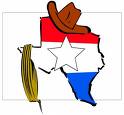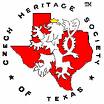

Before a Czech wedding could take place, the prospective couple had to own or rent land on which to farm. And nearly all the farms created a prosperous life for the first two generations. The Czech way of life is also described in another word: work. The Czechs, arriving long before the establishment of Czechoslovakia in 1918, were a Slavic people of Bohemia, Moravia, and Silesia. Texas became home for many of the Moravians, and the Moravian dialects became Texas Czech. Perhaps because of their many European years of domination by other peoples, Czechs arrived in Texas with a love of democracy and individuality.
| Czech presence in Texas has been clear and profound. For this group of Slavic peoples, language preservation marked, at one time, their ethnicity. Other traditions are obvious�foods and music among them�and for these people, farming was not just an occupation but a philosophic life goal. Many Czechs arriving from 1850 to the First World War considered the establishment of a self-sufficient farm as the most desirable, proper, creative way of life, not simply a way to make a living. On the ideal Czech farm, the family raised one cash crop (cotton or corn in Texas) and produced everything else they needed. The cash crop bought anything that could not be grown or made at home. |  |
| Immigrants settled in some 250 Czech communities mostly on the Blackland Prairie. Lavaca and Fayette Counties were heavily settled, with small centers appearing in Brazos, Burleson, and Williamson Counties. North of these areas, Czechs settled in Bell, McLennon, Ellis, Hill, and Kaufman Counties. Texas's Coastal Plain, below and within the German Belt, attracted hundreds of families. Fayetteville, originally a German settlement, became Czech by the 20th century. The city is often called the �cradle of Czech settlement in Texas.� Many Czech families, even though not settling nearby, passed through on their way up-country. |  |
|
For the Czechs, the retention of language, in addition to the establishment of farms, was key to their culture. Czech language classes were started everywhere there were Czechs. School lessons in Czech were held at Cat Spring by 1855, and Josef Ma��k opened classes at Wesley in 1859. By 1870 the school at Praha combined Czech with English instruction. And the younger generations advocated the study of the language in universities. This emphasis led to a widespread organization of Czech-language newspapers. Some 33 publications were established, and, even though the use of Czech dramatically declined, two papers still existed in the 1990's: Na�inec at Granger and Hospod�r at West. Other newspapers still contain Czech columns. Such a strong retention of language undoubtedly has much to do with the oral literatures�folktales, sayings, and songs�that remain in Czech areas. Czech communities, supported by strong fraternal and insurance organizations, still embrace wedding ceremonies, foods, music, and recent costume reproductions that are unmistakably European. Czech organizations were not all fraternal. The Cechie supported the teaching of advanced Czech as well as literature and history. In 1915 the organization was instrumental in influencing the University of Texas at Austin to establish a Chair of Slavic Languages. One of the most interesting organizations is the Sokol (�falcon�), which advocates the equal development of both mind and body. Essentially classical Greek in concept, the organization was founded in Prague in 1862, making its way to Texas by 1908. Sokol groups engage in gymnastics, dancing, singing, art, and literature. Today, nearly 170,000 Czech descendants maintain several community museums and a number of festivals in the state. Most Czechs have now left the family farm for urban occupatbut many smaller settlements remain on the map and in people's hearts. |  |